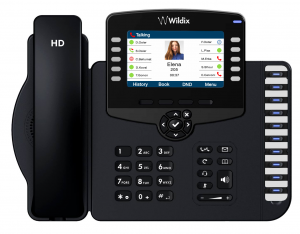In the previous blog article (Insight into the user endpoint) I listed user endpoints. This time I am going to characterize what advanced services can be implemented via SIP phones.
Feature Keys
On legacy systems and modern VoIP systems, feature keys can implement a large set of services:
- BLF (Busy Lamp Field), which displays the status of colleagues
- Parking slots
- Speed dial
- Send DTMF
- Trunk / line monitoring and use
Verify how many of these keys your users will need. Also, consider the possibility of providing such advanced services via the UC Client. For example, the user can own a basic VoIP phone for calls but manage all other operations (presence, monitoring, etc.) via the UC client on the PC.

EHS or Bluetooth Headset Support
Determine if your users will need a wireless headset with remote call control answer / hang up capability. On average, Bluetooth headsets are less expensive than DECT / EHS headsets, but have less coverage.
Such headset connectivity is usually offered as an add-on.
Video Support
Some devices come with built-in video support. Video support on phones is perfect to see and welcome visitors waiting in reception area of the company, and to activate remote door openers. Video phones can also be used to connect to remote security cameras. For these applications, a camera is not needed.
If you plan to use video phones as conferencing stations, verify in advance if the quality they provide is sufficient.
Backlight
As incredible as it might sound, there are still devices without a backlight in the lower price range.
Gigabit / Fast Ethernet / WiFi
Most phones offer Ethernet connectivity and an extra port to connect to a computer (in cascade fashion). This can greatly reduce cabling costs.
Choose Gigabit or fast Ethernet depending on whether the PC will be connected or not. Remember that VoIP calls use little bandwidth.
A word of advice on WiFi: Removing all network cabling might seem like a good idea. Make sure that the WiFi coverage and quality is compatible with VoIP services.
PoE (Power over Ethernet)
PoE is a great technology that provides connectivity and power in one single cable.
My suggestion is to always use PoE. It simplifies cabling and makes the phone service as reliable as the one offered by legacy systems.
Most legacy PBXs ensure service continuity during power outages using a battery, which is capable of powering all connected phones. The same should also be offered by modern UC servers. Let’s not forget that while voice calls are one of the services provided by our UC solution, they are also the way to request support in emergency situations by calling the police, firefighters, and hospitals.

